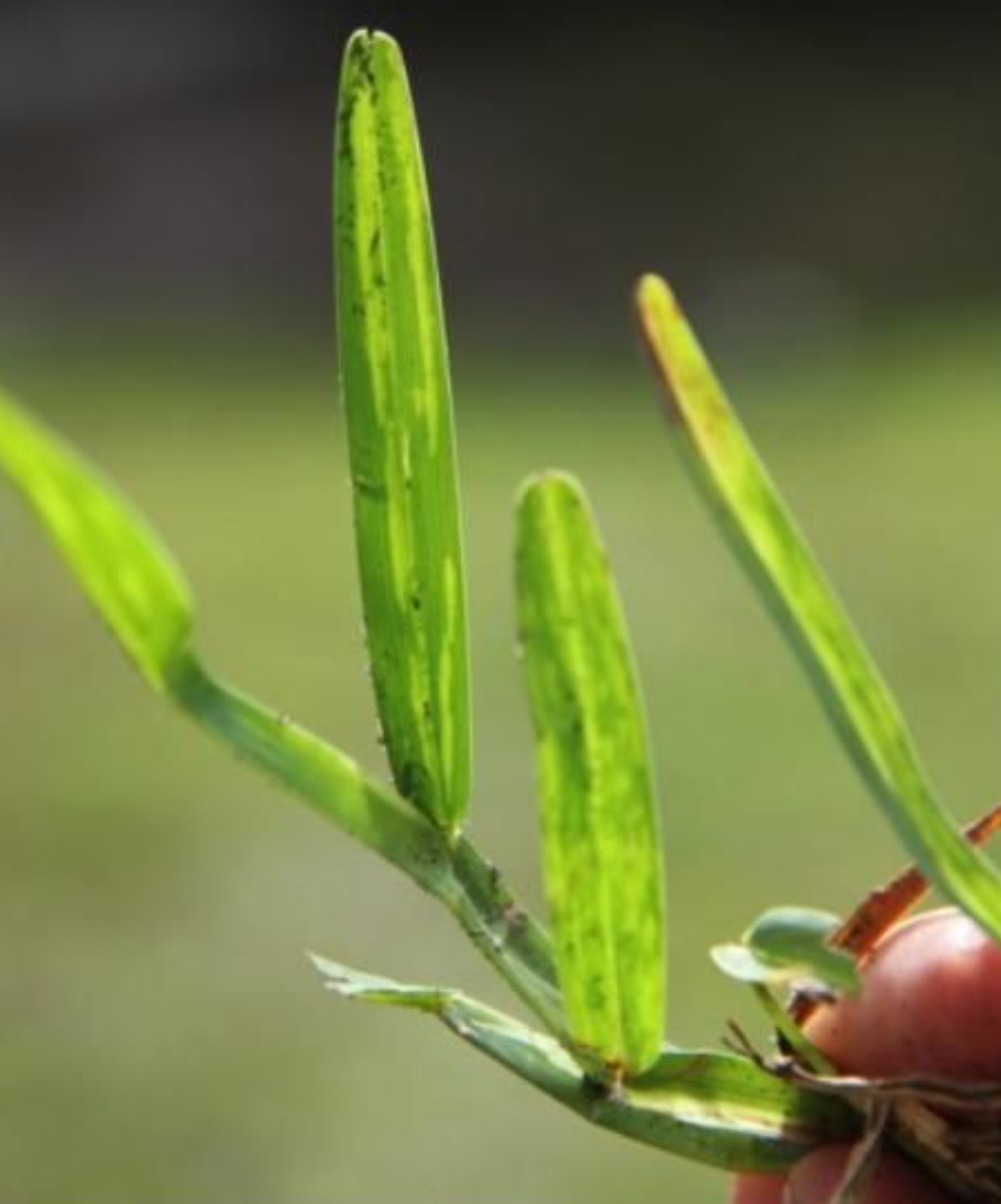In November 2014, Sugarcane Mosaic Virus (SCMV) was discovered in southeast Florida and Pinellas County where it seemed to stay. In the past few years, however, the virus has spread. It is now confirmed in counties in North, Central, and South Florida. Recently, lab reports confirm the disease is present in Hillsborough and Sarasota Counties.
SCMV leads to Lethal Viral Necrosis (LVN), resulting in the demise of Floratam lawns typically within three years of being infected. Floratam, the predominant cultivar of St. Augustinegrass in Florida, is highly susceptible to this virus. The symptoms of mosaic virus are typically more noticeable during cooler late summer, fall, and winter temperatures.
What are the Symptoms?

Mosaic disease symptoms occur on many plants, presenting as blotchy or streaky patterns of yellow and green color. Grasses showing mosaic symptoms tend to have broken yellow streaks running between veins on an otherwise green blade (Figure 1). Like most plant disease symptoms, mosaic patterns vary among grass varieties and species that they occur on and change appearance as the disease becomes more severe.
How Does SCMV Spread?
SCMV can be efficiently transmitted by mechanical means. Lawn mowers, line trimmers, and other equipment can transfer clippings and sap containing virus from lawn to lawn. Aphids are known to transmit the virus as well, but it is not known how important aphids or other potential insect vectors are for disease spread. The virus also can be spread on infected sod during the times of year when symptoms are mild and not obvious. Sod with SCMV should not be used.
How Can You Manage SCMV?
Some cultivars of St. Augustinegrass are more at risk than others. ‘Floratam’ is particularly vulnerable and can progress to LVN. This is particularly true in South Florida. ‘Palmetto’ and ‘CitraBlue’ are more resistant. SCMV also affects sugarcane, bermudagrass, seashore paspalum, bahiagrass, and fountaingrasses. Zoysiagrass does not appear to be a host.
- Plant host resistance is the best management tool for viral diseases.
- No pesticides (fungicides, insecticides, etc.) are effective in controlling SCMV.
- Avoid mowing when the grass is wet. It facilitates the distribution of the virus containing plant sap.
- Remove clippings and any other plant material from equipment before moving to another lawn and then spray down parts of equipment or worker’s shoes that have the potential to transfer plant sap using dilute bleach, quaternary ammonia (Green-Shield), alcohol, or another sanitizing agent according to the directions.
- Promote the most vigorous growth possible with best management practices for fertilization, watering, mowing height and fungal management. See http://edis.ifas.ufl.edu/lh010
Mosaic is just one of many diseases that may be causing problems on a lawn. To confirm the virus and other diseases, submit a sample to a UF/IFAS Plant Diagnostic Center (https://plantpath.ifas.ufl.edu/extension/plant-diagnostic-center/).
More helpful Information:
Southwest Florida UF/IFAS commercial horticulture contacts:
- Manatee County: Michelle Atkinson
- Hillsborough County: Susan Haddock
- Pinellas County: Steve Robinson
- Polk County: Luis Rodriguez
- Sarasota County: Ashley Ellis
- Charlotte County: Ralph Mitchell
- Lee County: Stephen Brown
- Collier County: Ryan Czaplewski
- other counties can be found here
Sources for this blog:
- https://edis.ifas.ufl.edu/publication/PP313
- https://gardeningsolutions.ifas.ufl.edu/lawns/problems-and-solutions/sugarcane-mosiac-virus-in-turfgrass.html
- https://discover.pbcgov.org/coextension/horticulture/pdf/commercial/Sugarcane%20Mosaic%20Virus.pdf
Note: All images and contents are the property of UF/IFAS.



